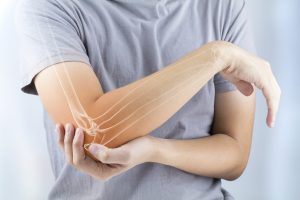Ulnar nerve transposition at the Elbow
The Pathway of the Ulnar Nerve
 The ulnar nerve innervates off the cervical and thoracic spine in the four foraminal canals between levels C-7 and T-2. Two nerve innervations, the C-8 and T-1 nerve roots, travel to the left side of the body and two travel to the right side of the body. Before the nerves pass through the shoulder joint, they join into each other to form one thick nerve bundle. The nerve pass between the collarbone and scapula, passes over the inner front side of the shoulder along the armpit and runs down the inside of the arm. The ulnar nerve has the most exposure when passing through the elbow as it approaches the closest to the skin in its journey. The ulnar nerve enters the elbow joint around the prominent lump on the inside of your elbow that we refer to as our funny bone. The funny bone, or medial epicondyle, jets off the humerus as an attachment point for ligaments to connect the humerus to the ulna.
The ulnar nerve innervates off the cervical and thoracic spine in the four foraminal canals between levels C-7 and T-2. Two nerve innervations, the C-8 and T-1 nerve roots, travel to the left side of the body and two travel to the right side of the body. Before the nerves pass through the shoulder joint, they join into each other to form one thick nerve bundle. The nerve pass between the collarbone and scapula, passes over the inner front side of the shoulder along the armpit and runs down the inside of the arm. The ulnar nerve has the most exposure when passing through the elbow as it approaches the closest to the skin in its journey. The ulnar nerve enters the elbow joint around the prominent lump on the inside of your elbow that we refer to as our funny bone. The funny bone, or medial epicondyle, jets off the humerus as an attachment point for ligaments to connect the humerus to the ulna. The ulnar nerve passes through the joint and then follows the ulna along the pinky side of your inner forearm into the fingertips. The ulnar nerve controls and provides sensation to the forearm muscles that attach to your flexor tendons of the pinky and ring fingers, as well as many of the muscles in your hand, the muscles that bend your wrist, and provides sensation for portions of the outer hand.
The ulnar nerve passes through the joint and then follows the ulna along the pinky side of your inner forearm into the fingertips. The ulnar nerve controls and provides sensation to the forearm muscles that attach to your flexor tendons of the pinky and ring fingers, as well as many of the muscles in your hand, the muscles that bend your wrist, and provides sensation for portions of the outer hand.
Cubital Tunnel Syndrome
As the ulnar nerve passes the medial epicondyle it travels through the cubital tunnel. Ligaments the connect the medial epicondyle to the ulna leave a small gap between the bones called the cubital tunnel. This tunnel of tissue possesses varying degrees of space for the ulnar nerve to travel through depending on genetics. Some people have a tight space that can impede the gliding of the nerve back and forth during motion of the elbow causing the nerve to stretch. Stretching nerves, just like any other tissue, may not cause issues for small stretches, but as the amount of tension increases tissue damage can occur, even small amounts, that causes inflammation and irritation. Patients that have their ulnar nerves stretched experience symptoms such as tingling, numbness, burning, aching, and muscle weakness. In addition to stretching the ulnar nerve some people experience cubital tunnel syndrome from compression of the nerve as well. Simple things such as the pressure from a table or chair can press the nerve until it falls asleep causing the pins and needle sensation. In cases of patients where the cubital tunnel has too much space for the nerve to move around the nerve may slip over bony protrusions of the elbow causing irritation that mimics the symptoms of the previously mentioned causes of ulnar nerve irritation. Prolonged cases of cubital tunnel syndrome may cause a loss of strength that can lead to muscle wasting if left unchecked over time.
Treating Cubital Tunnel Syndrome
The first step to treating cubital tunnel syndrome involves coming to a proper diagnosis. Nerve issues tend to present with the same symptoms and while there may be slight variations between spine issues, such as cervical stenosis, and cubital tunnel syndrome a doctor will need to properly rule out more serious issues if a physical examination leaves some ambiguity. Diabetes, auto immune issues, thyroid disease, and nerve impingement may all present with similar symptoms. Doctors may order an X-Ray and/or MRI imaging as well as a nerve conduction study to find the proper diagnosis in some cases, but many cases respond to the physical examination to give clear signs. One of the first things patients can try to see if they get relief includes sleeping with their arms out straight. Patients that sleep with their elbows bend pull on the nerve all night long and may wake up with numb ring fingers and pinkies. They may feel like they are wearing gloves and drop objects like drinking glasses. These symptoms may resolve as easily as putting a pillow between their arms at night while they side sleep to keep their elbows straight. In patients are unable to keep their arms straight while sleeping a splint or brace may help. NSAIDs may reduce swelling, and if they don’t then steroids offer a stronger anti-inflammatory state. Physical therapy helps by teaching the patient exercises that focus on getting the nerve to glide through the cubital tunnel more freely. Some patients may even benefit from using a soft pad to rest their elbow on while sitting for prolonged periods if hard surfaces are compressing their ulnar nerve. In patients that don’t respond to the conservative treatments then surgical intervention may offer them the relief that they cannot find.
Surgical intervention: Ulnar nerve transposition at the elbow
Patients that do not respond to conservative treatments for cubital tunnel syndrome can consider surgical intervention in cases where their nerve issues of the cubital tunnel are not secondary in nature to conditions such as diabetic neuropathy or multiple sclerosis. If the cause lays entirely in the cubital tunnel and all other treatments fail surgeons can remove the nerve from the cubital tunnel and move it to the other side of the medial epicondyle. The ulnar nerve will no longer have issues with entrapment, but the new anterior positioning leaves very little tissue between the nerve and you may find that your nerve has new positions that cause discomfort under certain circumstances. The surgical wound heals in two to four weeks while you wear a splint to keep the elbow in a bent position to allow the nerve to properly set into its new position, but the internal structures take three to six months to fully recover with proper post-operative care. Post-operative care will include range of motion oriented physical therapy at first to reduce pain and swelling, and then strength recovery will follow if the patient needs it. Healing time will vary from patient to patient based on general health, age, and other lifestyle factors such as smoking.

